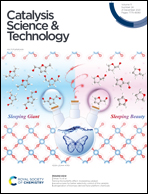Tuning CuZn interfaces in metal–organic framework-derived electrocatalysts for enhancement of CO2 conversion to C2 products†
Abstract
The electrochemical CO2 reduction reaction (CO2RR) is an effective and green approach for reducing and converting CO2 synchronously into high-value chemicals and fuels, especially C2 products. We report here the synthesis of bimetallic CuZn electrocatalysts supported on conductive porous carbon for the CO2RR through a one-step carbonization of a metal–organic framework (MOF). By varying the Cu/Zn ratios of the MOF, we obtain catalysts with differing Cu–Zn interfaces including alloy and segregated phases, which significantly affect the Faradaic efficiency and current density of ethylene and ethanol. CuZn alloy with intimate contact between Cu and Zn exhibits the highest improvement (5-fold) in Faradaic efficiency for the C2 products at −1 VRHE compared to the Cu counterpart, far outperforming the catalyst with segregated Cu and Zn phases. The reaction pathway towards ethylene and ethanol over the CuZn alloy catalyst is investigated using density functional theory calculations with an explicit solvent model, and the roles of Zn in influencing the electronic structure of the Cu sites to favor C2 production are clarified.



 Please wait while we load your content...
Please wait while we load your content...